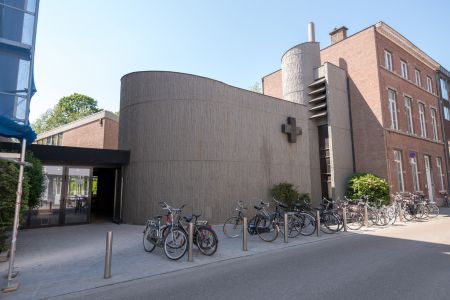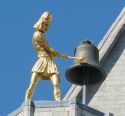Church | | Contemporary | Catholic Church

Map
Opening hours
01 January - 31 December
Mon 9.00 - 19.00
Tue 9.00 - 19.00
Wed 9.00 - 19.00
Thu 9.00 - 19.00
Fri 9.00 - 19.00
Sat 9.00 - 19.00
Sun 9.00 - 19.00
Religious offices
Description
In the chapel, a miraculous and crowned Virgin Mary statue named ‘Our-Lady-of-Fevers’ is being worshiped, a statue dating from the end of the 15th century (origin: place of pilgrimage in the Leuven Vleminckx chapel). In the church stands, among other things,. a protected Cavaillé-Coll organ (from after 1800).
Chapel and church (1974) (entrance in the Bogaardenstreet in Leuven) are the work of the renowned architect Victor Broos (1908-1980). In both chapel and church, many works of art are being preserved and are on display: i.a. a series of processional banners and statues from our former Neo-Gothic parish church (1870-1970).
KIKIRPA : Photo-library online
Photos
Remarkable elements
The church building - Architect designer Victor Broos (1908-1980)
In the official real estate inventory are mentioned, amongst other valuable buildings, as its most important constructions after world war two: the Leuven warehouse, the holy church of Dominic Savio situated in Dilbeek, and the Saint Joseph church located in Leuven. This church was described as “a modern church”, according to the building permit from 1973, together with its cafeteria and Sunday School room, it was designed to be a liturgical center. The Saint Joseph’s church has a very unusual design fitting the designer Broos’ portfolio and is quite remarkable by its total absence of windows at the front of the building.
Cavaillé-Coll organ
Originally from the Neo-Gothic Saint-Jospeph’s church (1860-1971).
In 1969, Paul Eraly wrote in his visit report “The organ of Saint-Joseph, a Cavallié-Col, probably from 1871, is an instrument that was perfectly preserved, and which therefore assures us that it came from a great company, the very best that was available at the time.” It became a protected monument on 10-12-1981 due to its musical, historical, esthetic, and art-craft value. The organ is still being played at every liturgical celebration.
Our-Lady-of-Fevers
Polychrome wooden Pieta from the 15th-16th century.
This miraculous statue originally came from the Vleminckx chapel in the Vlamingenstraat (translated: Flemish street) in the city of Leuven, a place that has been a known sanctuary for centuries. The statue was officially crowned by Cardinal Mercier on 06/16/907. In 1988, when the fathers left the church and the monastery building of the Friars Minor, the statue was ceded on loan to the Saint-Joseph council.
Partly due to the ever growing attention as a result of the Corona epidemic, the statue was relocated on 11/21/2021 to the adjacent Lady Chapel in a secured display cabinet that was specifically designed for this purpose by the Bailleul company.
Processional banners, statues, and furniture (19th-20th century)
These banners, each one being of important historical value, were restored and preserved by Kenny Damiaan between 2010-2014. The most important statues from the old church - Saint-Joseph holding hands with the young boy Jesus, Mary holding the child Jesus in her arms, the Sacred Heart statue, and the statue of Christ that stood on the main altar, received a fixed place in the church as well as the chapel.
Monstrance
On special occasions, the Tree monstrance (1810), the Tower monstrance (1629) and other liturgical objects and robes are put on display.
Garden
The adjacent park garden with entrance to an integrated private parking that one can access from the Burgemeesterstraat (translated: Mayor street) with a direct passage to and from the church.
The garden, originally owned by a Leuven wine merchant, became at a later date a monastery of the Servite Order, has a remarkable plantation of ancient exotic trees such as a ailanthus (China), a sophora from Japan, next to a couple of gigantic beeches, a weeping beech, a colorful maple tree, etc.
The ideal meeting place to listen to the carillon of the university library nearby.
















